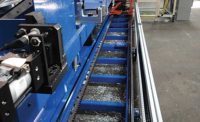Heinrich Witzenmann’s influence on manufacturing may have begun in 1885, when he invented the metal hose, but it continues to this day. The company he founded has continually grown over the past 130 years to become the world’s leading manufacturer of flexible metal elements.
When product designers require an expansion joint to compensate for movements, they often use one made by the Pforzheim, Germany-based Witzenmann Group. The company’s other popular metal products include bellows, components and pipe supports for plant equipment, manufacturing cells and fully automated production lines.
Timo Conzelmann, electrical designer at Witzenmann, notes that staff toolmakers and mechanical engineers work closely when designing each of the company’s fabricating machines. Assembly of the machines is performed by workers with extensive experience in laser treatments, welding and soldering.
For many years, the company used its computer-aided engineering (CAE) software to document the performance of the machines’ electrical systems, as well as to modify supplier plans when required. In 2013, however, management decided to expand its use of the software, which is made by EPLAN Software & Services LLC.
“We took on the electrical and software engineering of our machines to retain even more expertise in-house,” recalls Conzelmann. “Now, we can see a machine’s development from its conception to assembly.”
Witzenmann has increasingly implemented the various modules of its CAE software the past five years, and recently upgraded to EPLAN’s Electric P8 2.5 for all electrical engineering work related to its machines. The company also uses Pro Panel software for virtual 3D control cabinet design, EPLAN Fluid software for fluid power engineering applications and the Engineering Control Center (ECTR) interface to access the component database in the company’s enterprise resource planning (ERP) system.
“The complete machine is shown in CAD, not just its mechanical aspects,” notes Jürgen Rausch, IT project leader at Witzenmann. “[The] electrical and mechanical designs are merged.”
Conzelmann says four things enabled the company to smoothly integrate its CAD and CAE software. One was a shared mechatronic bill of materials. Another was using the eCl@ss cross-branch classification and product description standard to document technical features and harmonize the separate electrical and mechanical engineering structures.
The third and fourth were the flexibility of all departments involved in the process, and the full support of EPLAN’s consulting division to help those affected at Witzenmann. All four factors resulted in some key changes to the product development process.
For starters, the structure of the schematic circuit diagram is now jointly agreed upon prior to use by mechanical design engineers. Workers then use the eCl@ss system to easily integrate the diagram into the ERP via ECTR.
The software also lets engineers more easily design new machines. “To configure a new machine from existing [ones], we divide the main project into sub-projects to enable the easy addition and deletion of standard engineering modules,” explains Conzelmann. “If a welding machine needs to be equipped with a saw, we just add the saw module [with] a [mouse] click. We don’t have to redesign it every time from scratch.”
For more information on engineering and design software, call 847-240-4667 or visit www.eplanusa.com.








